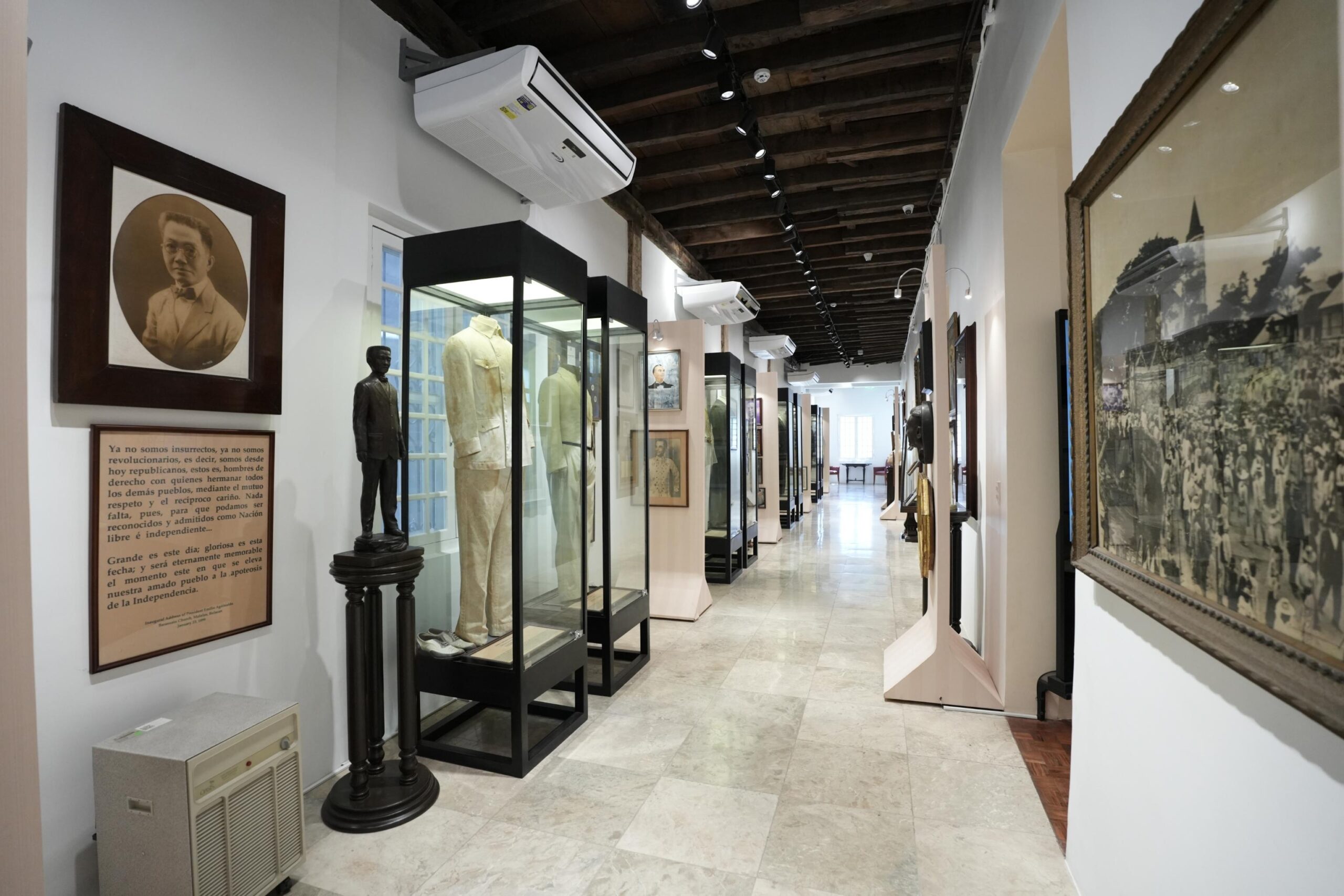
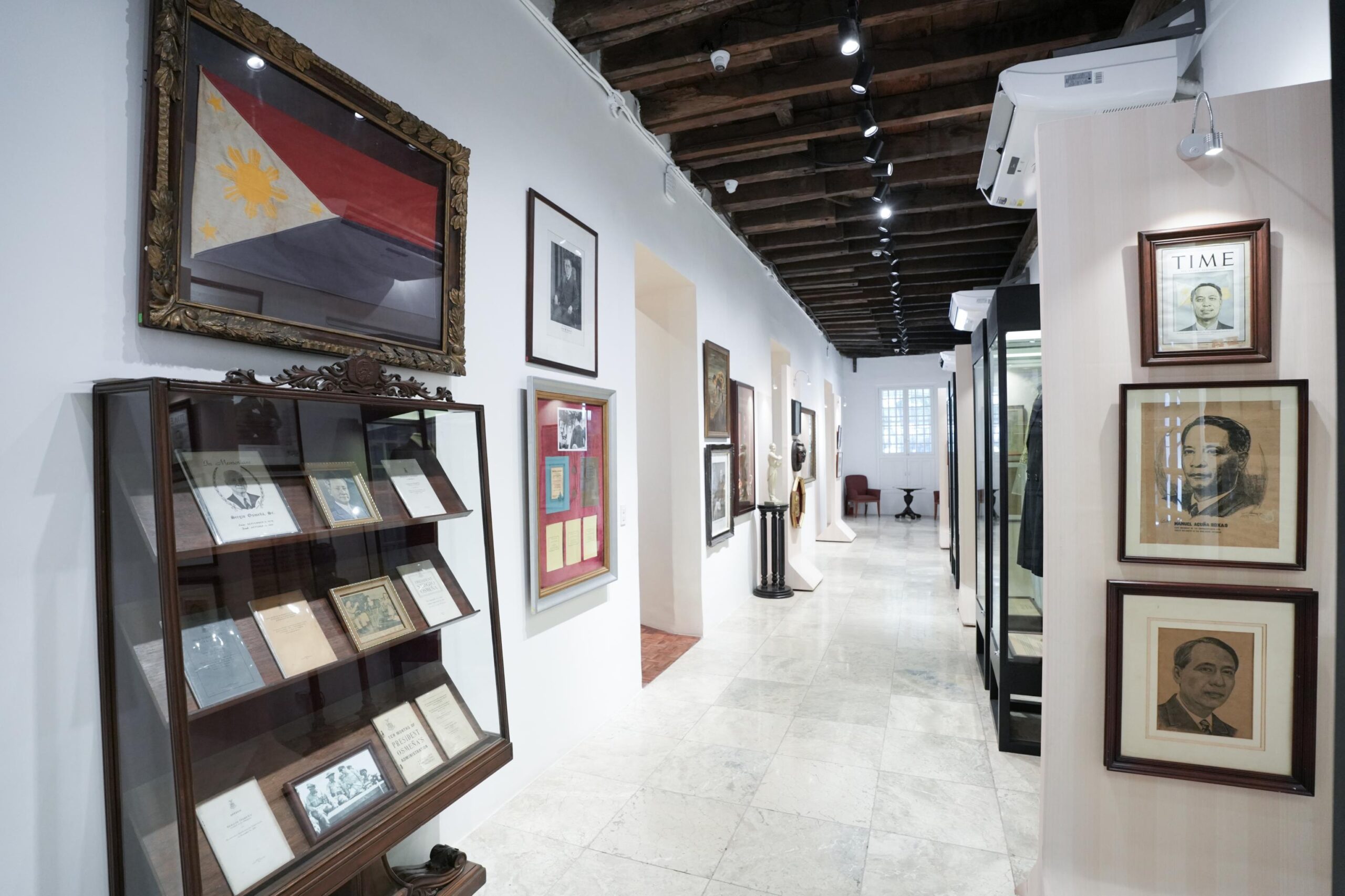
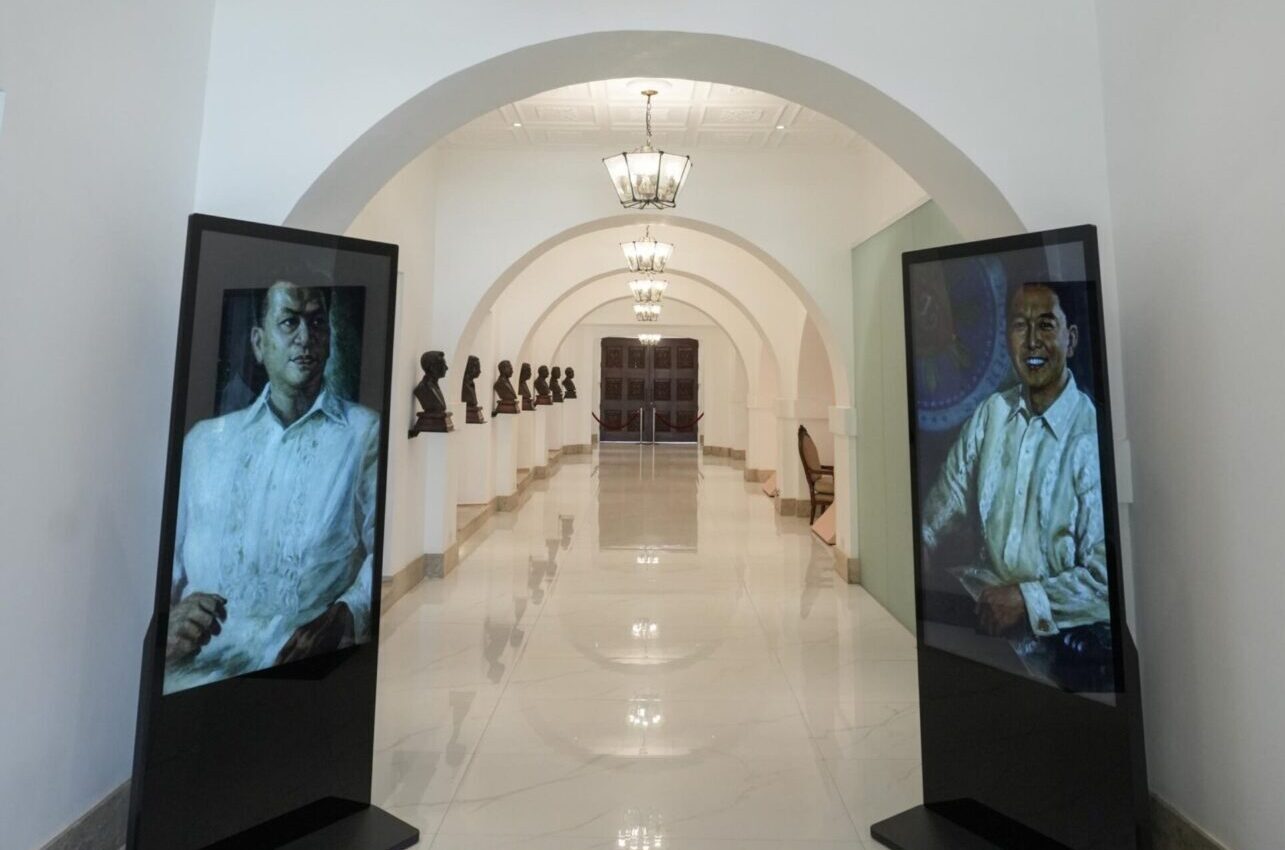
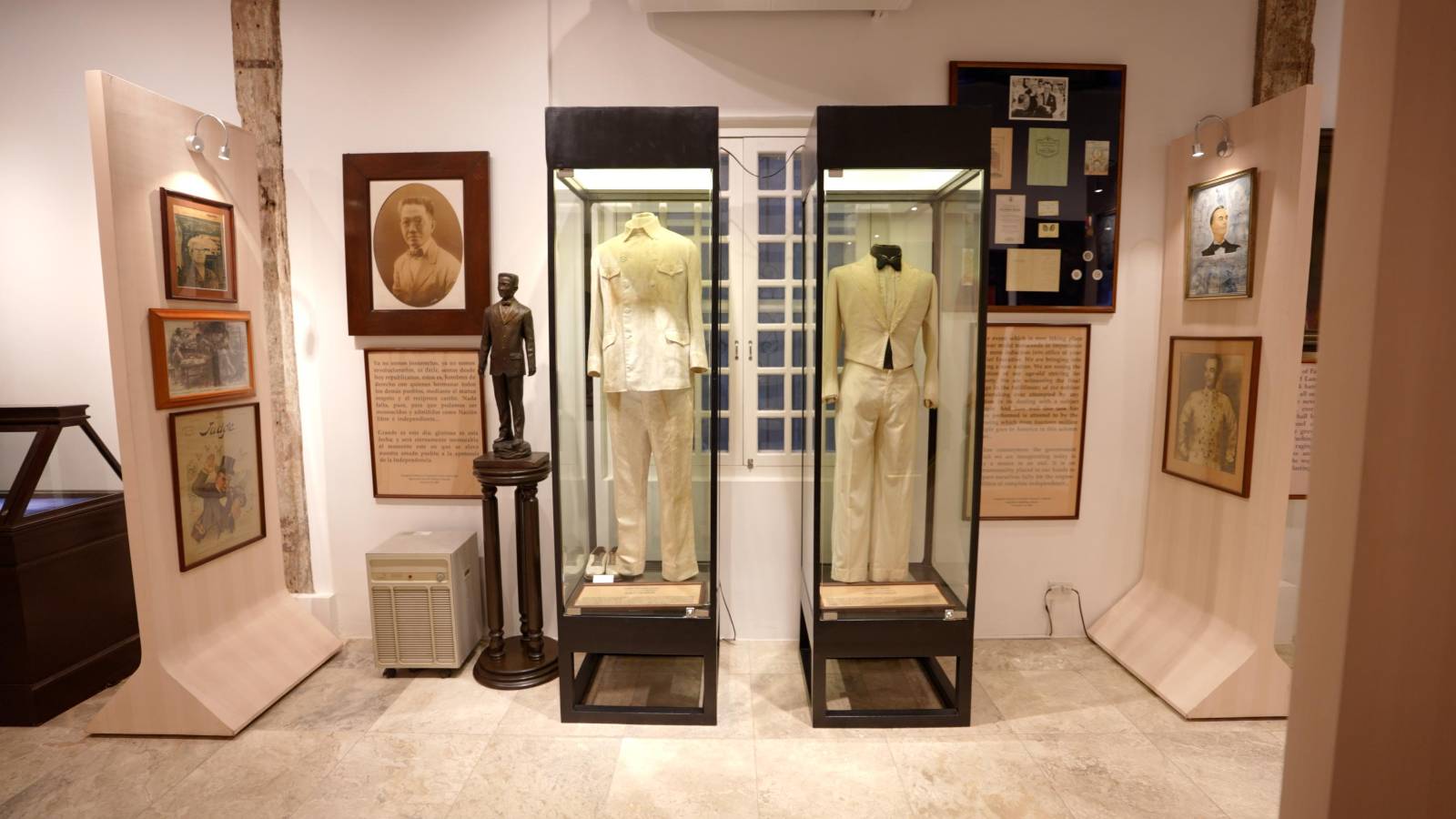




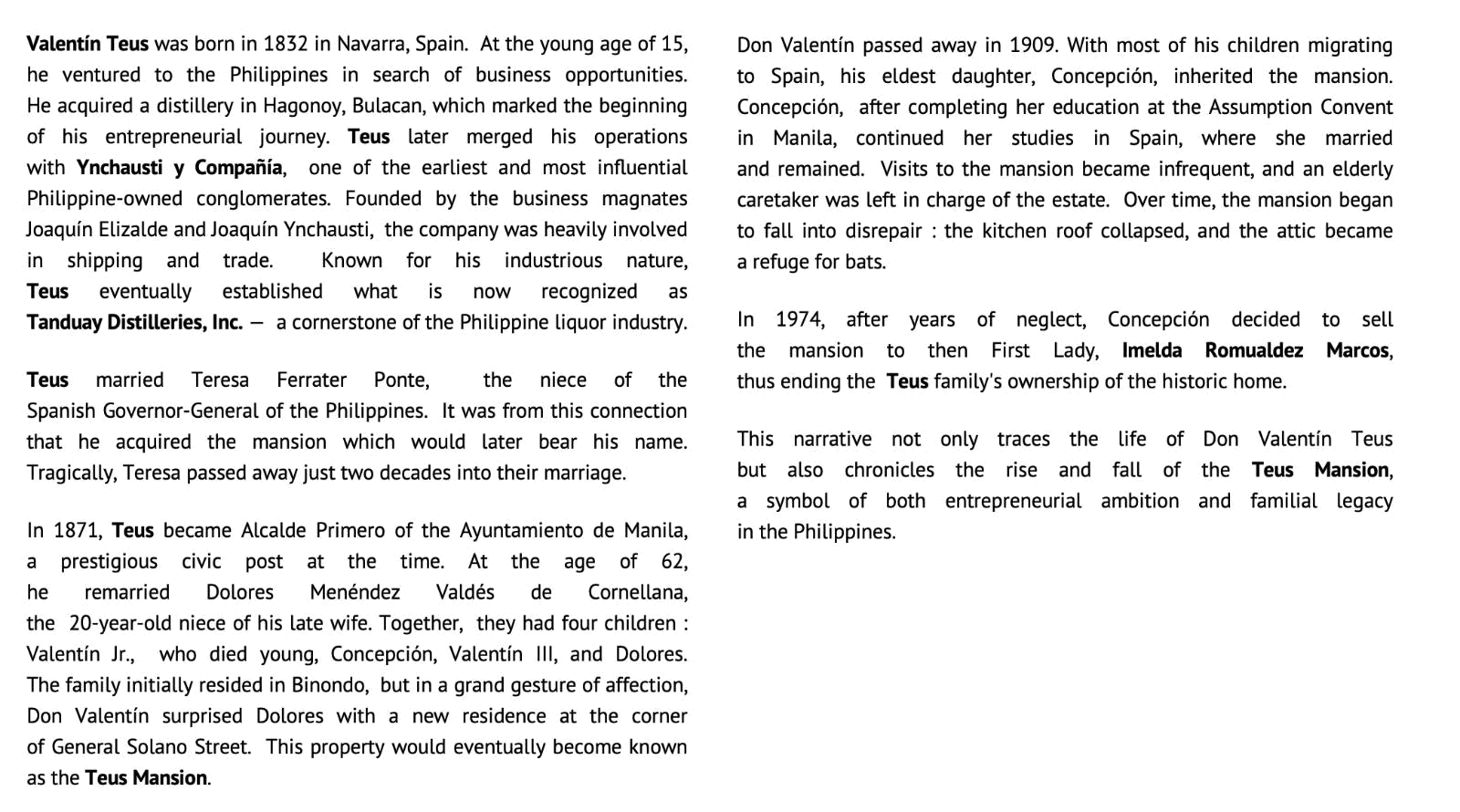
Valentín Teus was born in 1832 in Navarra, Spain. At the young age of 15, he ventured to the Philippines in search of business opportunities. He acquired a distillery in Hagonoy, Bulacan, which marked the beginning of his entrepreneurial journey. Teus later merged his operations with Ynchausti y Compañía, one of the earliest and most influential Philippine-owned conglomerates. Founded by the business magnates Joaquín Elizalde and Joaquín Ynchausti, the company was heavily involved in shipping and trade. Known for his industrious nature, Teus eventually established what is now recognized as Tanduay Distilleries, Inc.— a cornerstone of the Philippine liquor industry.
Teus married Teresa Ferrater Ponte, the niece of the Spanish Governor-General of the Philippines. It was from this connection that he acquired the mansion which would later bear his name. Tragically, Teresa passed away just two decades into their marriage.
In 1871, Teus became Alcalde Primero of the Ayuntamiento de Manila, a prestigious civic post at the time. At the age of 62, he remarried Dolores Menéndez Valdés de Cornellana, the 20-year-old niece of his late wife. Together, they had four children: Valentín Jr., who died young, Concepción, Valentín III, and Dolores. The family initially resided in Binondo, but in a grand gesture of affection, Don Valentín surprised Dolores with a new residence at the corner of General Solano Street. This property would eventually become known as the Teus Mansion.
Don Valentín passed away in 1909. With most of his children migrating to Spain, his eldest daughter, Concepción, inherited the mansion. Concepción, after completing her education at the Assumption Convent in Manila, continued her studies in Spain, where she married and remained. Visits to the mansion became infrequent, and an elderly caretaker was left in charge of the estate. Over time, the mansion began to fall into disrepair : the kitchen roof collapsed, and the attic became a refuge for bats.
In 1974, after years of neglect, Concepción decided to sell the mansion to then First Lady, Imelda Romualdez Marcos, thus ending the Teus family's ownership of the historic home.
This narrative not only traces the life of Don Valentín Teus but also chronicles the rise and fall of the Teus Mansion, a symbol of both entrepreneurial ambition and familial legacy in the Philippines.
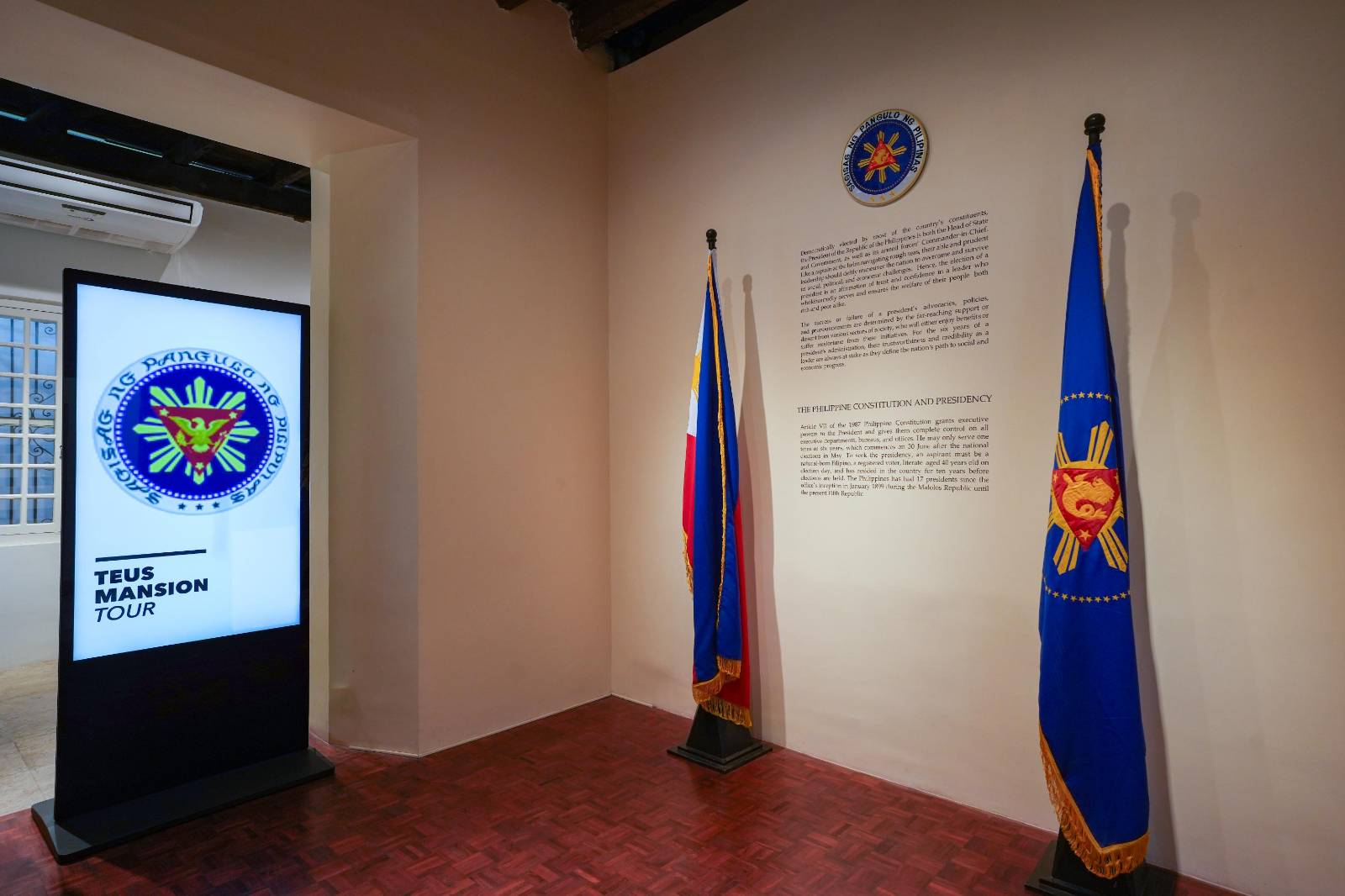
This gallery showcases the Philippine National Flag, Presidential Flag, and the Presidential Seal, with the current seal first used by President Manuel Roxas in 1947.
A distinctive feature of the Presidential Flag and Seal is the sea lion, a heraldic symbol granted by King Philip II of Spain in 1596, reflecting the Philippines' colonial heritage. The sun with eight rays represents the provinces that were placed under martial law during the Philippine Revolution of 1896, while the three stars symbolize the country's three main regions— Luzon, Visayas, and Mindanao.
These symbols highlight the nation's journey from colonial rule to independence, encapsulating its rich history and unity.
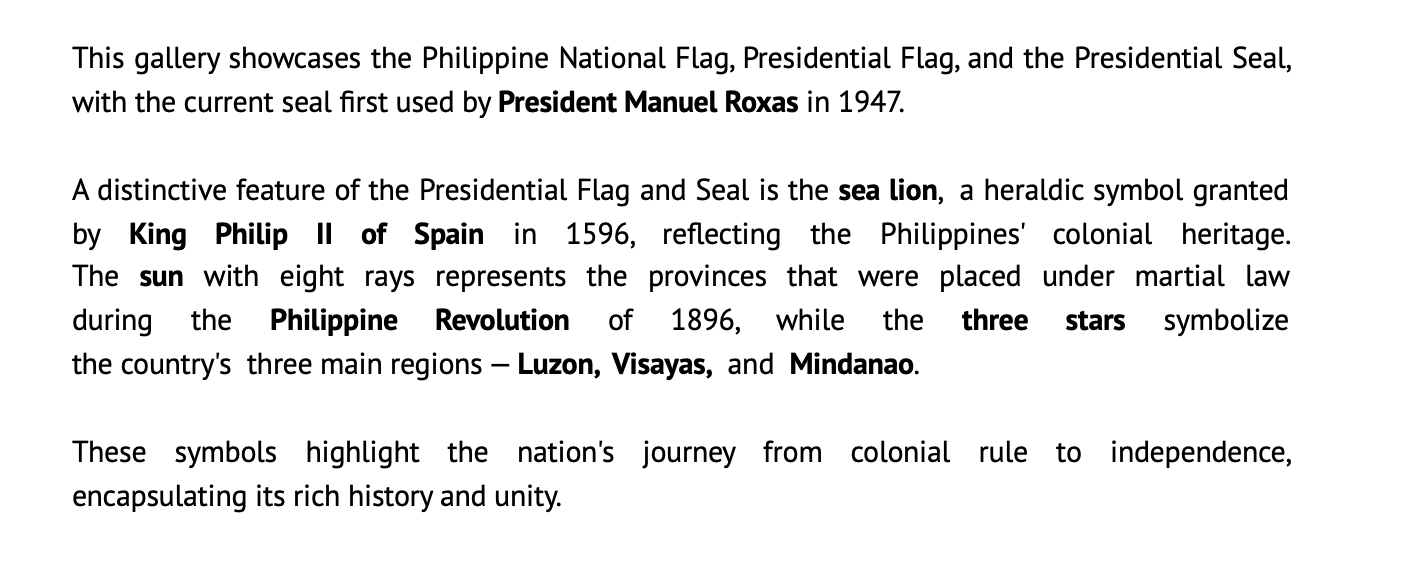
President Emilio Aguinaldo
General Emilio Aguinaldo, a prominent leader of the Katipunan in Cavite, emerged as the recognized leader of the Philippine Revolution. On 23 January 1899, he was elected as the first President of the Philippines by the Malolos Congress of the First Philippine Republic, marking a significant milestone in the nation’s fight for independence.
President Manuel L. Quezon
Revered as the "Paladin of Philippine Freedom," President Manuel L. Quezon played a pivotal role in securing the passage of the Tydings-McDuffie Act by the United States Congress, which laid the foundation for the Philippines' transition to an independent republic. Due to the challenges posed by the Japanese occupation during World War II, President Quezon was compelled to lead the government in exile from the United States, continuing his efforts to secure the nation’s sovereignty.
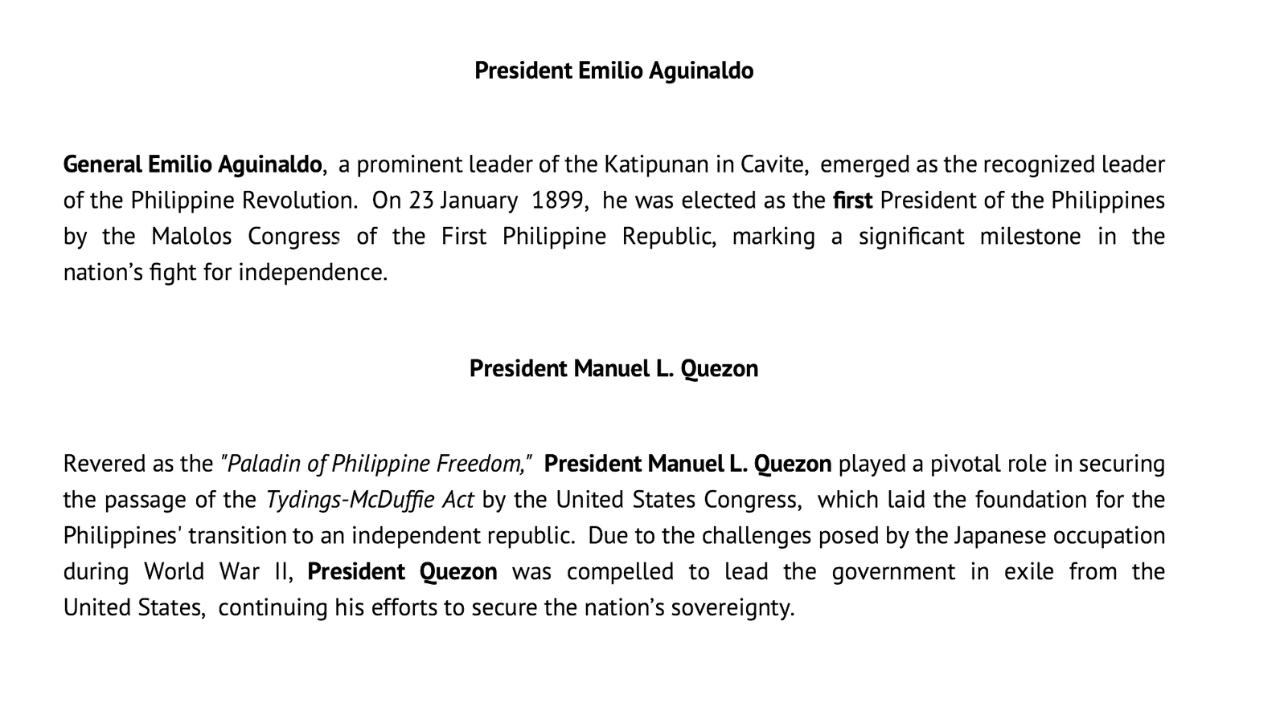
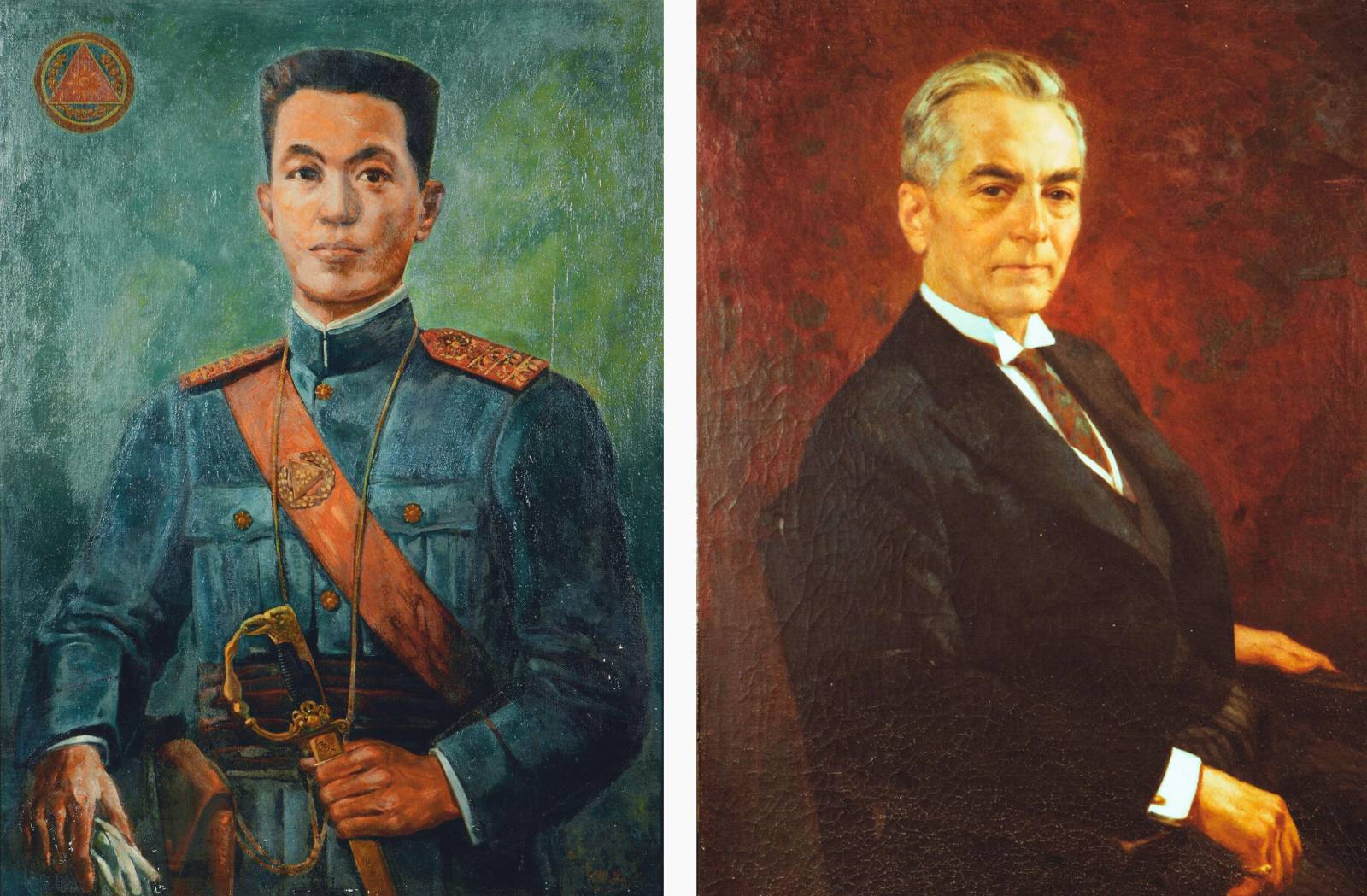
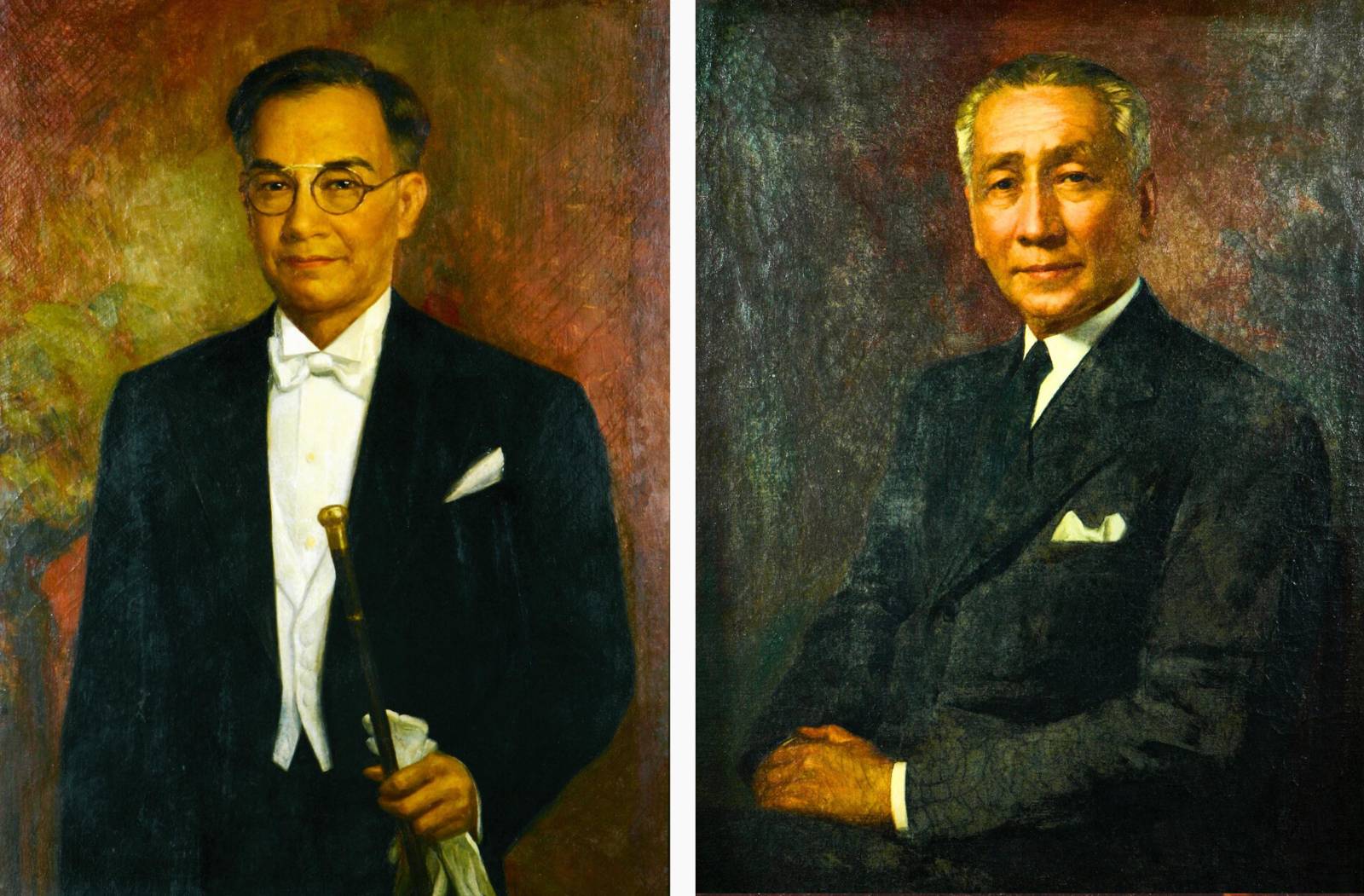
President Jose P. Laurel
After having served the country in various elective and appointive posts before and during the Quezon administration -- including Secretary of the Interior and Justice of the Supreme Court, Laurel was instructed by Quezon to remain in the Philippines during the wartime occupation. Laurel was subsequently elected President by the National Assembly. He made use of this opportunity to ameliorate the plight of his countrymen during the Japanese occupation.
President Sergio Osmeña
A lawyer and newspaper editor, Osmena became the Governor of Cebu in 1904. He resigned in 1906 and was subsequently elected as a member of the new Philippine Assembly. He served in this capacity as founding Speaker until his election to the Senate in 1922.
While in exile with Quezon, he succeeded as President of the Commonwealth upon the latter’s death in 1944. He famously “returned” to the Philippines with General Douglas MacArthur and worked towards our war-torn country's rehabilitation.
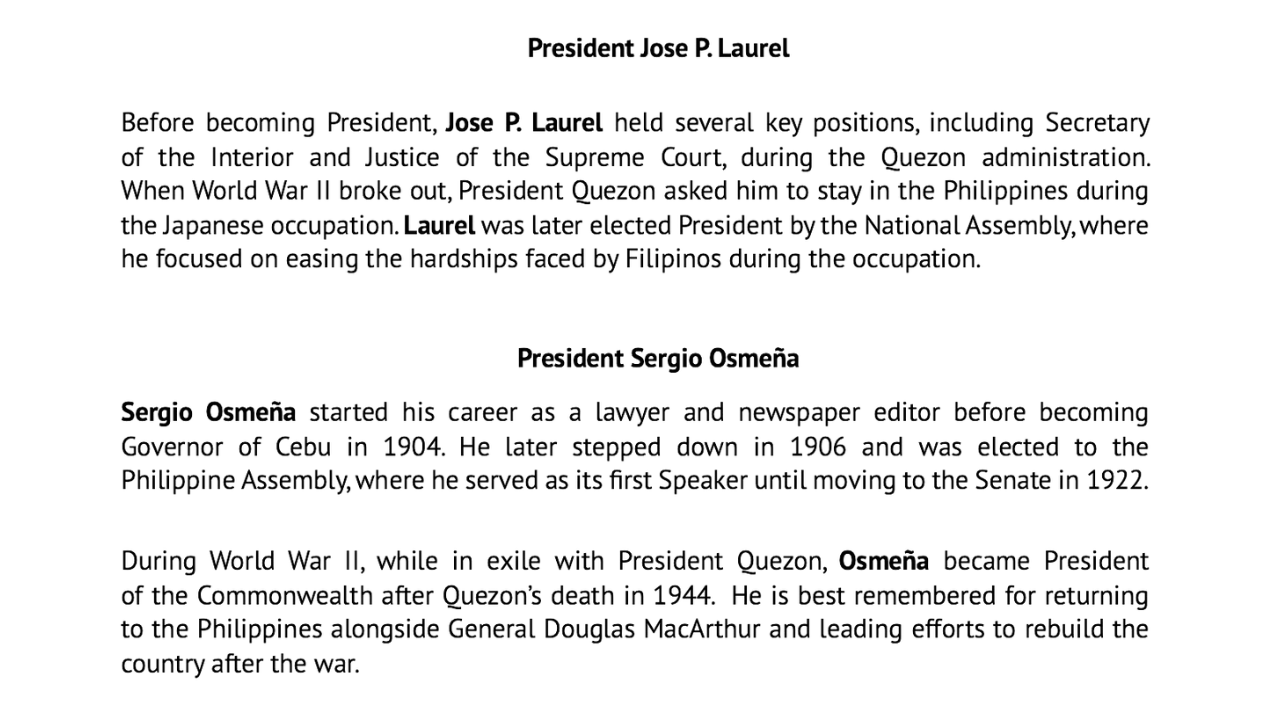
President Manuel A. Roxas
In 1934, Manuel A. Roxas played a key role as a member of the Constitutional Convention, which drafted the 1935 Constitution. During the Pacific War, circumstances required him to serve under the Japanese-sponsored government. Following his victory over President Osmeña in the 1946 elections, Roxas became the last President of the Commonwealth and, on 4 July 1946, was inaugurated as the first President of the Third Republic of the Philippines.
President Elpidio R. Quirino
Elpidio R. Quirino began his public service as a practicing lawyer before being elected to the House of Representatives in 1919 and later to the Senate in 1925. He worked closely with President Quezon to secure the passage of the Tydings-McDuffie Act of 1934, which laid the groundwork for Philippine independence. After enduring the tragic loss of most of his family during the war, Quirino was elected Vice President and assumed the presidency following the untimely passing of President Roxas in 1948.
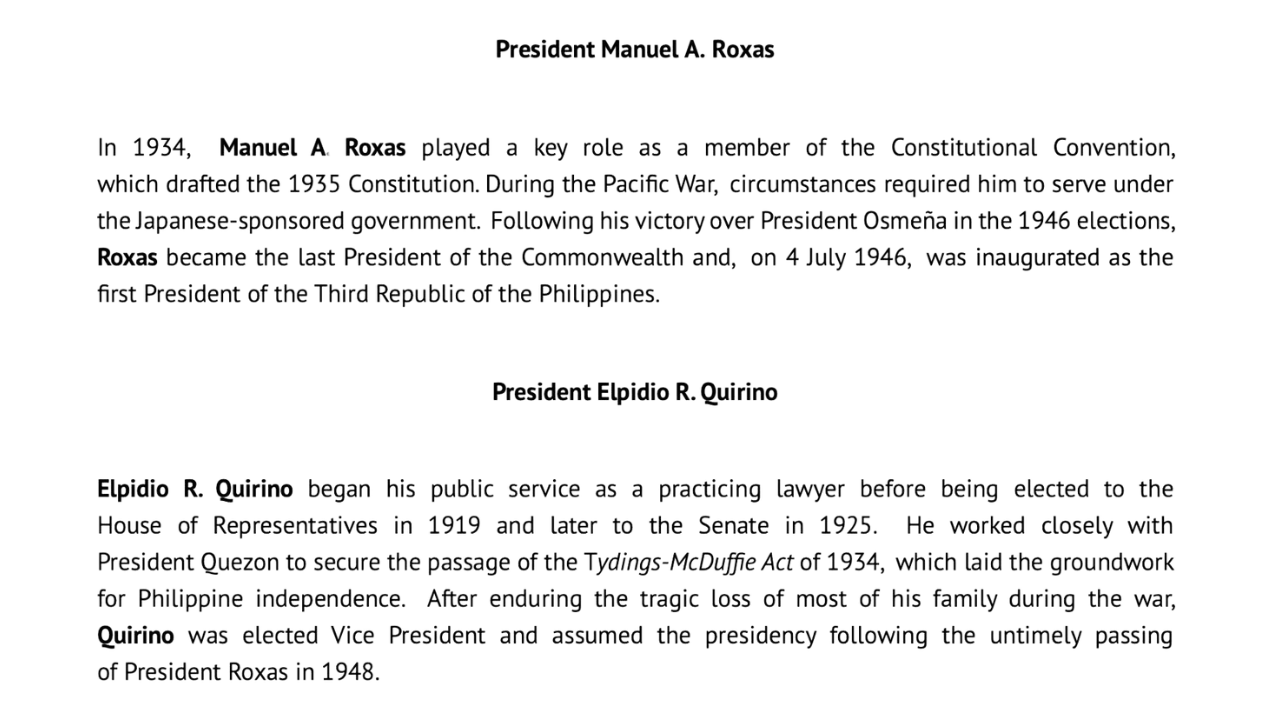
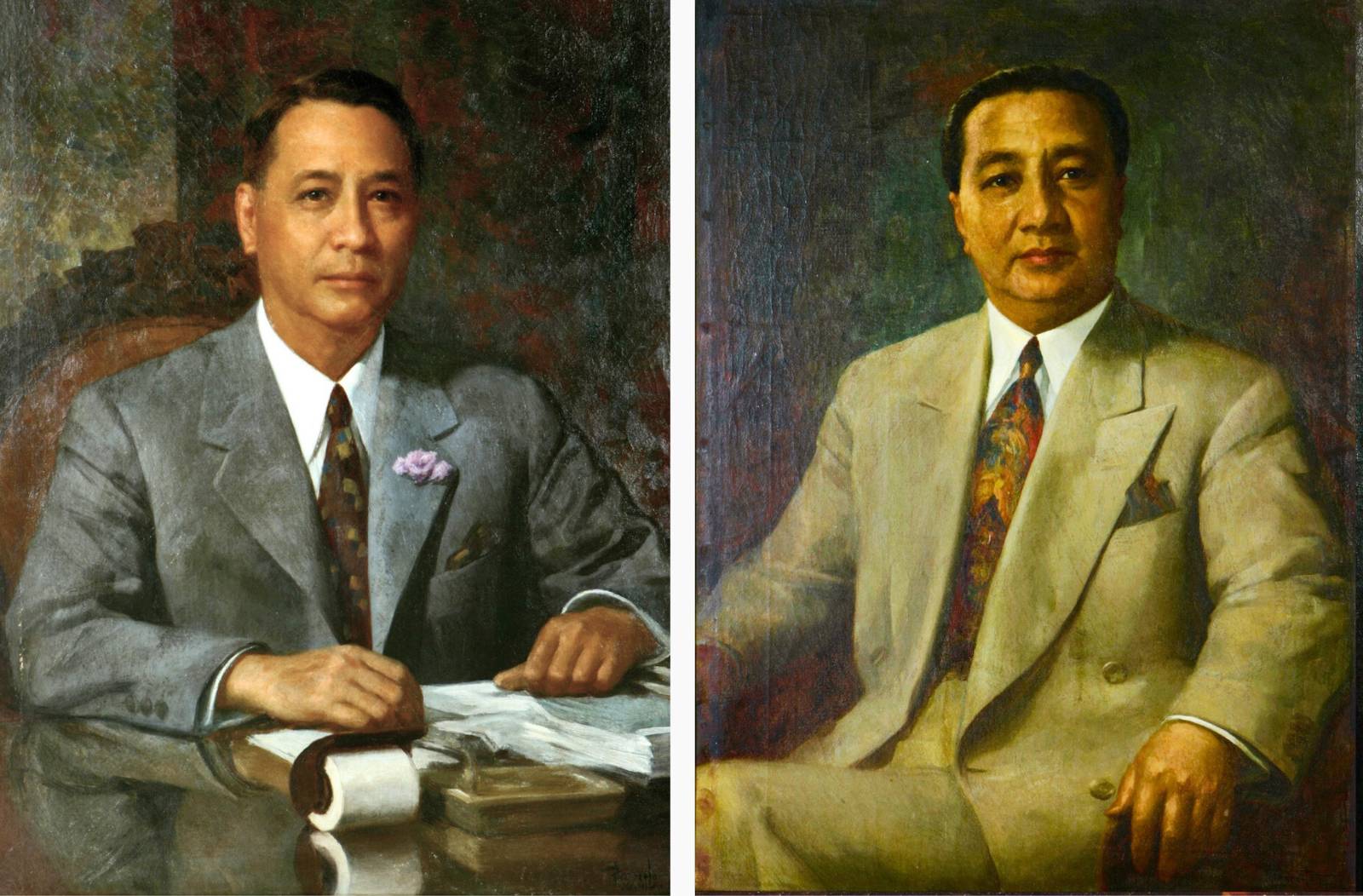
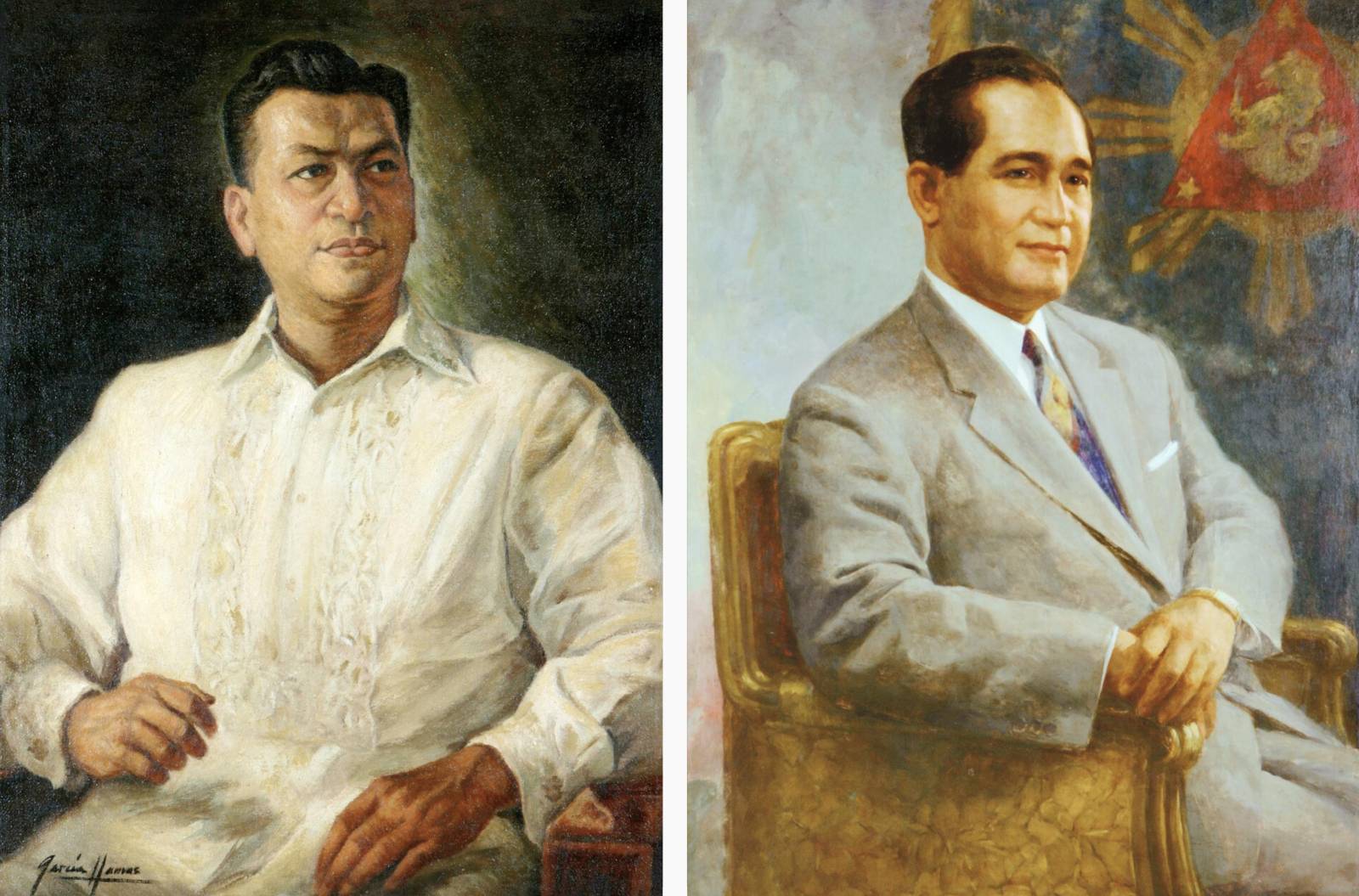
President Ramon F. Magsaysay
Originally an automobile mechanic, Ramon F. Magsaysay distinguished himself as a guerrilla leader during the Pacific War, leading to his appointment as military governor of Zambales. He later served two terms as Congressman for Zambales under the Liberal Party. Recognized for his leadership, he was appointed Secretary of National Defense by President Quirino. In 1953, Magsaysay won the presidency under the Nacionalista Party, marking a new chapter in Philippine leadership.
President Carlos P. Garcia
President Carlos P. Garcia played a pivotal role in advocating for the Philippines' war damage claims in the United States following the Pacific War. After succeeding Magsaysay as President following his tragic death, Garcia was elected to the presidency in his own right later that year. He became widely known for his austerity program and for promoting economic nationalism through his "Filipino First Policy," which prioritized the welfare of Filipino businesses and industries.
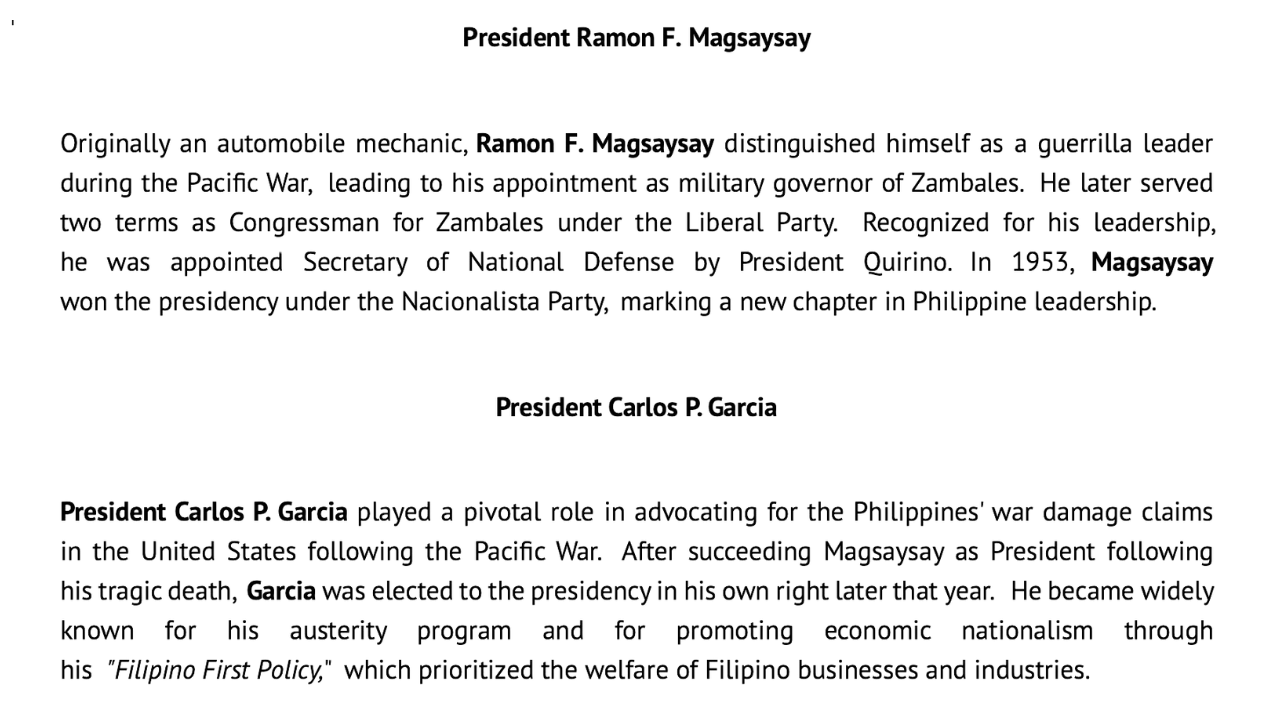
President Diosdado P. Macapagal
Affectionately known as the "poor boy from Lubao" in Pampanga, Diosdado P. Macapagal first entered public service as a Congressman in 1949. He was elected Vice President in 1957 under the Liberal Party. During his presidency, Macapagal championed comprehensive land reform and prioritized initiatives aimed at improving the lives of the poor, underscoring his commitment to social and economic development.
President Ferdinand E. Marcos
Ferdinand E. Marcos began his political career with three terms as a member of the House of Representatives, later being elected to the Senate, where he became Senate President in 1959. Running under the Nacionalista Party, he was elected President in 1965. His administration is noted for its focus on infrastructure development, among other initiatives. On 21 September 1972, citing threats of subversion and rebellion, President Marcos declared martial law and temporarily suspended Congress as part of his efforts to address national security concerns.
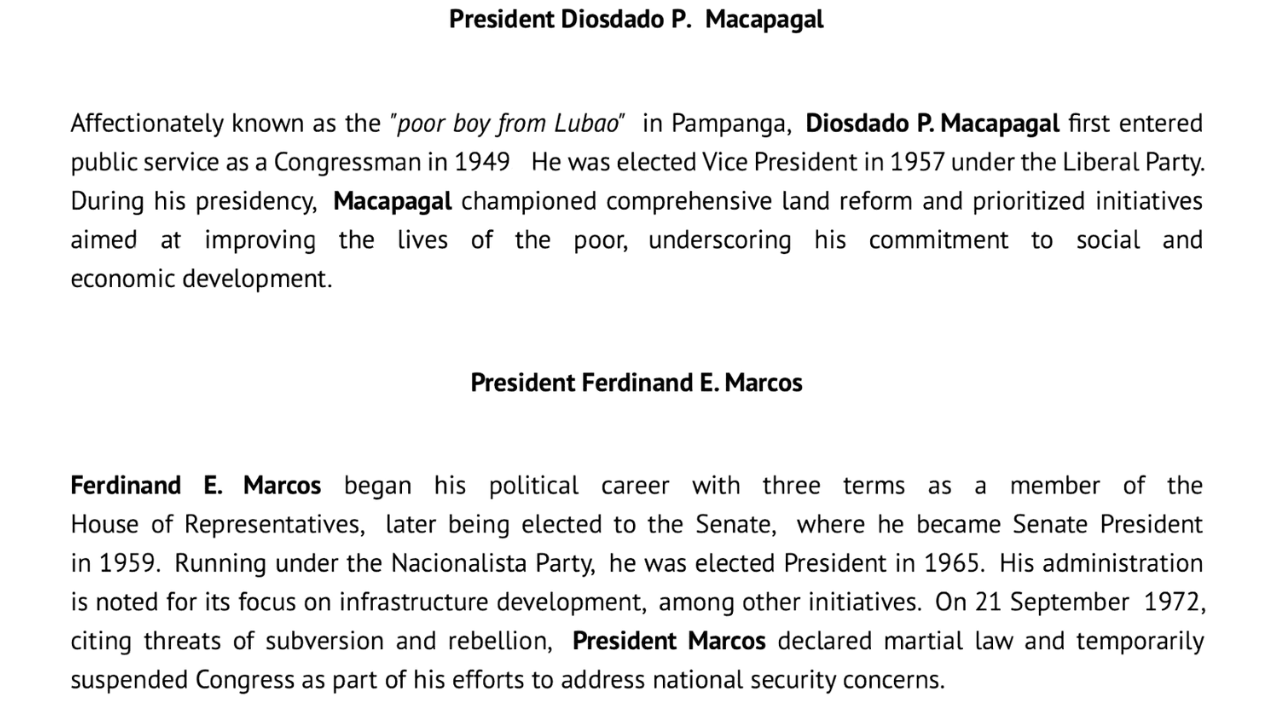
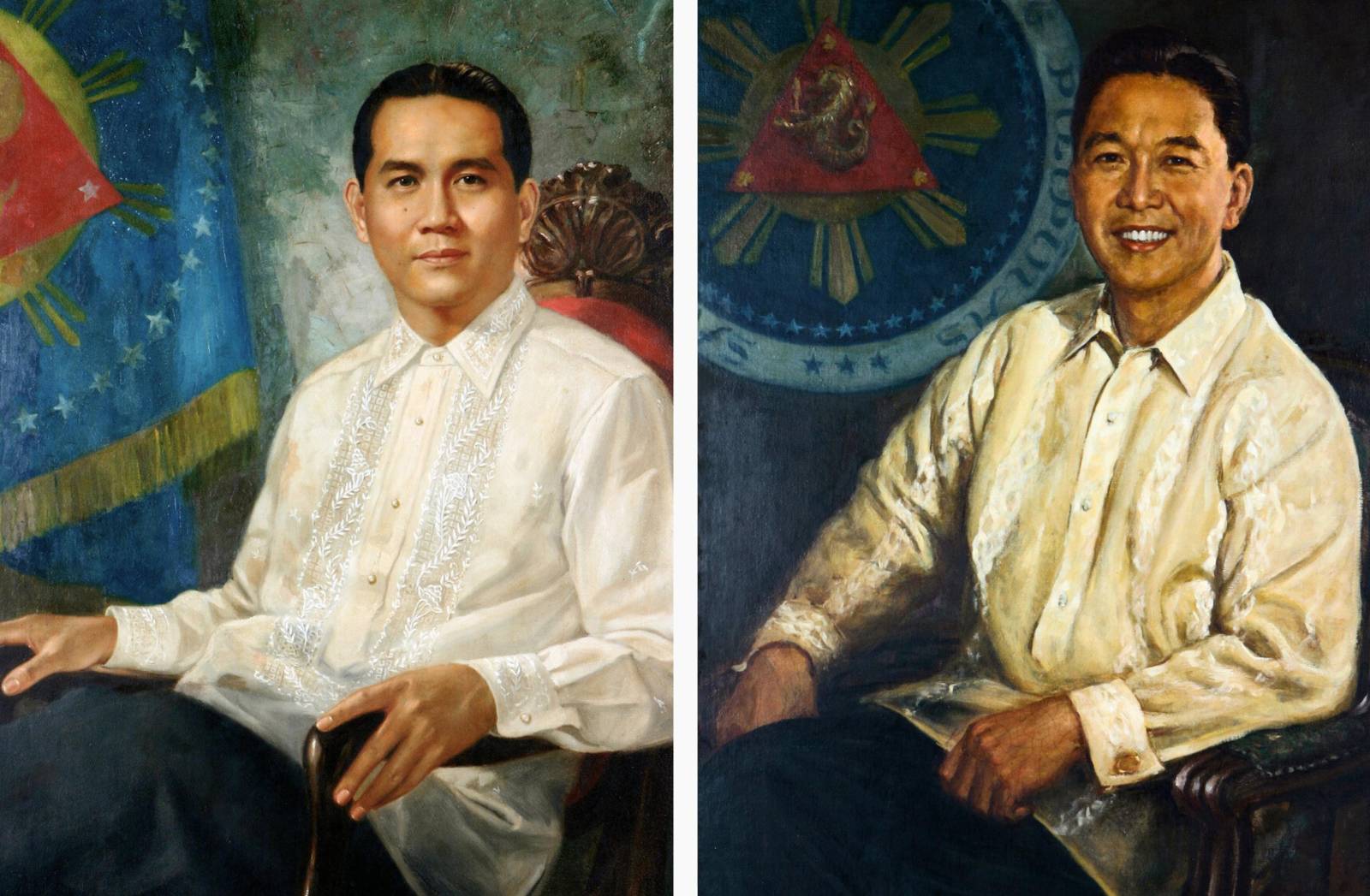
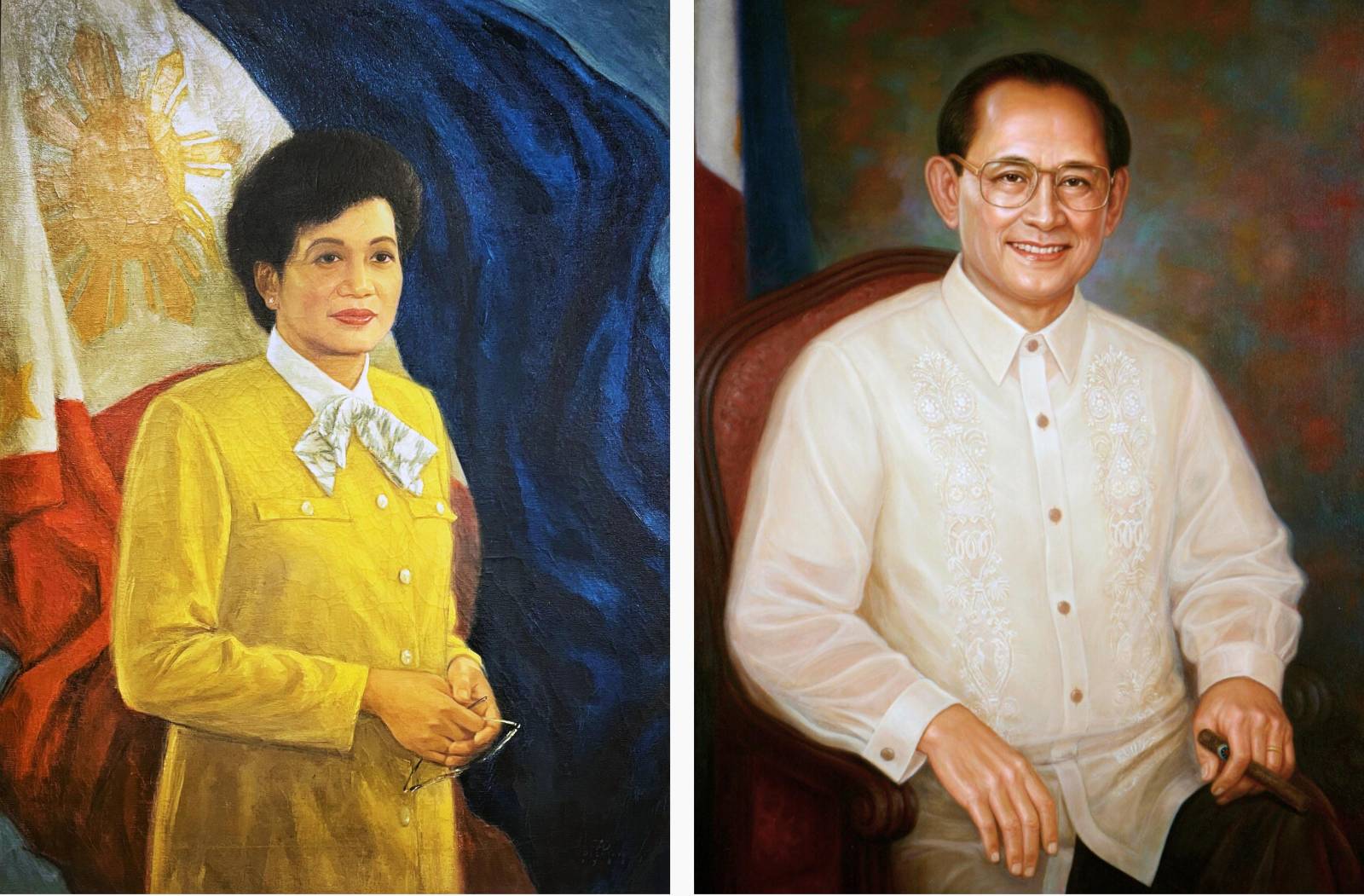
President Corazon C. Aquino
Cory Aquino assumed the presidency on 25 February 1986, following the historic events of what is now known as EDSA People Power Revolution, which led to the departure of President Marcos from the country. During her administration, a new Constitution was ratified on 2 February 1987, marking the establishment of the Fifth Republic of the Philippines.
President Fidel V. Ramos
A career military officer, Fidel V. Ramos served as the Chief of the Philippine Constabulary under President Marcos. In 1986, he became Chief of Staff of the Armed Forces and was later appointed Secretary of National Defense by President Aquino. Elected to the presidency in 1992, Ramos is known for his efforts in negotiating peace with Communist and Muslim rebel groups and for introducing significant economic reforms aimed at liberalizing key sectors of the economy.
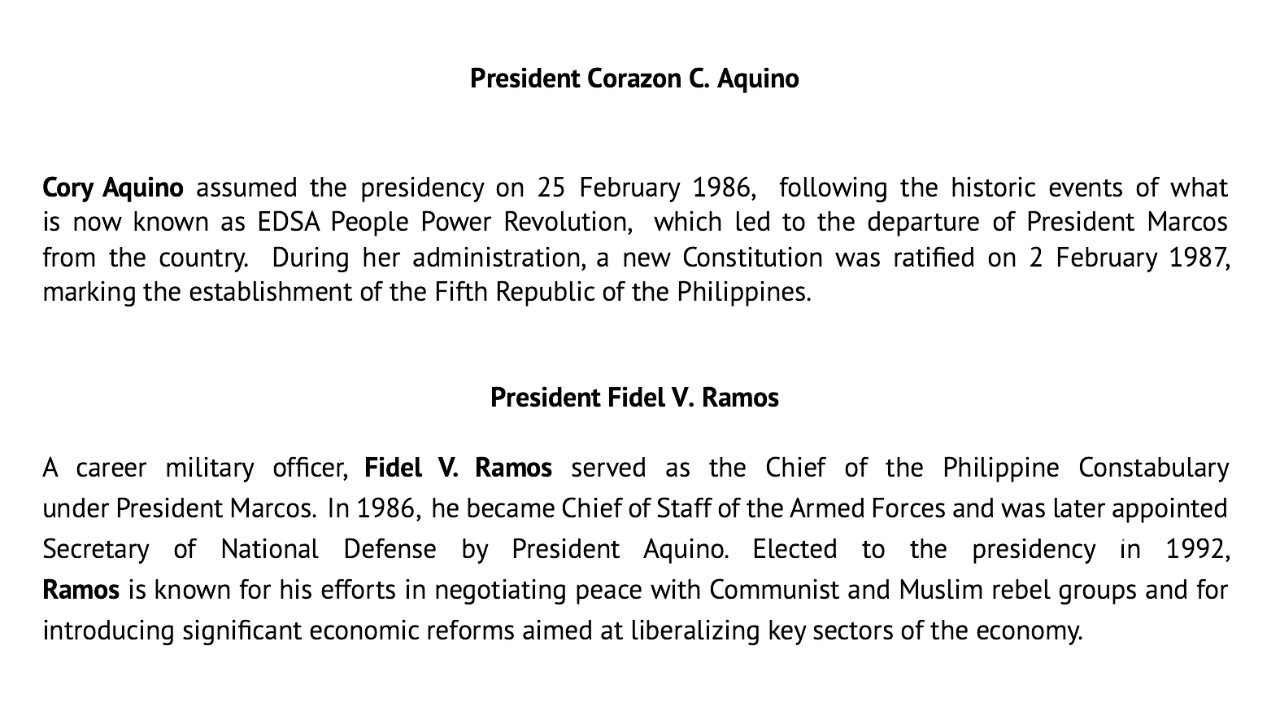
President Joseph E. Estrada
Joseph E. Estrada began his political career in the 1960s, first serving as Mayor of San Juan before being elected to the Senate and later as Vice President. In 1998, he was elected as President of the Philippines. During his tenure, he adopted a firm stance against Muslim rebel groups and focused on initiatives aimed at reducing crime and poverty. On 20 January 2001, following the events of what is now known as EDSA Dos, he stepped down from the presidency.
President Gloria Macapagal Arroyo
Elected as Vice President in 1998, Gloria Macapagal Arroyo was appointed by President Estrada as Secretary of Social Welfare and Development. She succeeded Estrada in 2001 following his resignation. After completing the remainder of her predecessor’s term, Arroyo won the Presidential election in 2004, continuing her leadership of the nation.
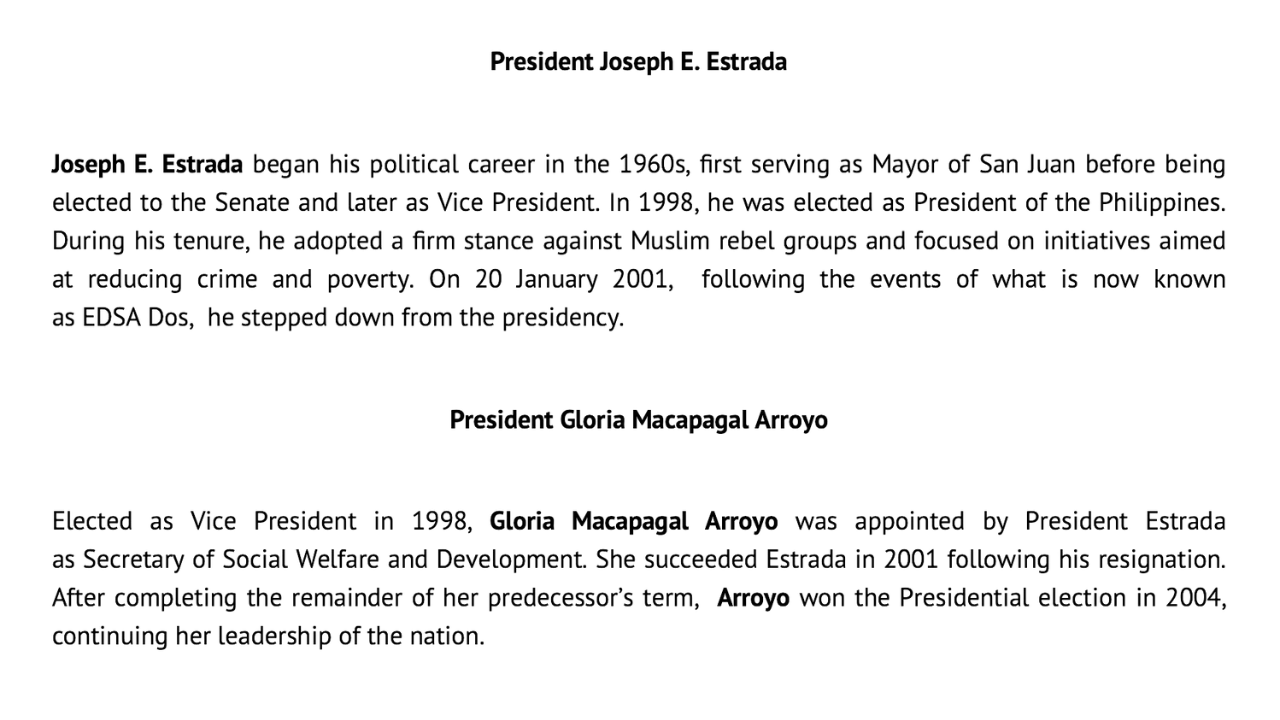
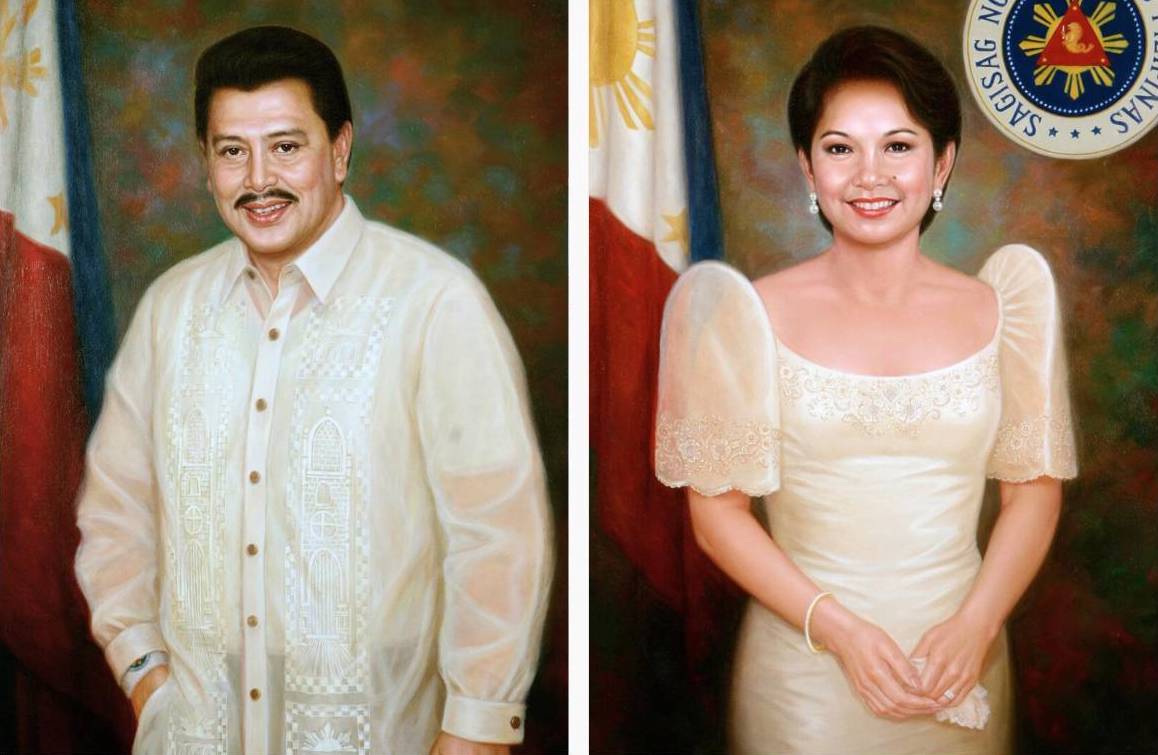
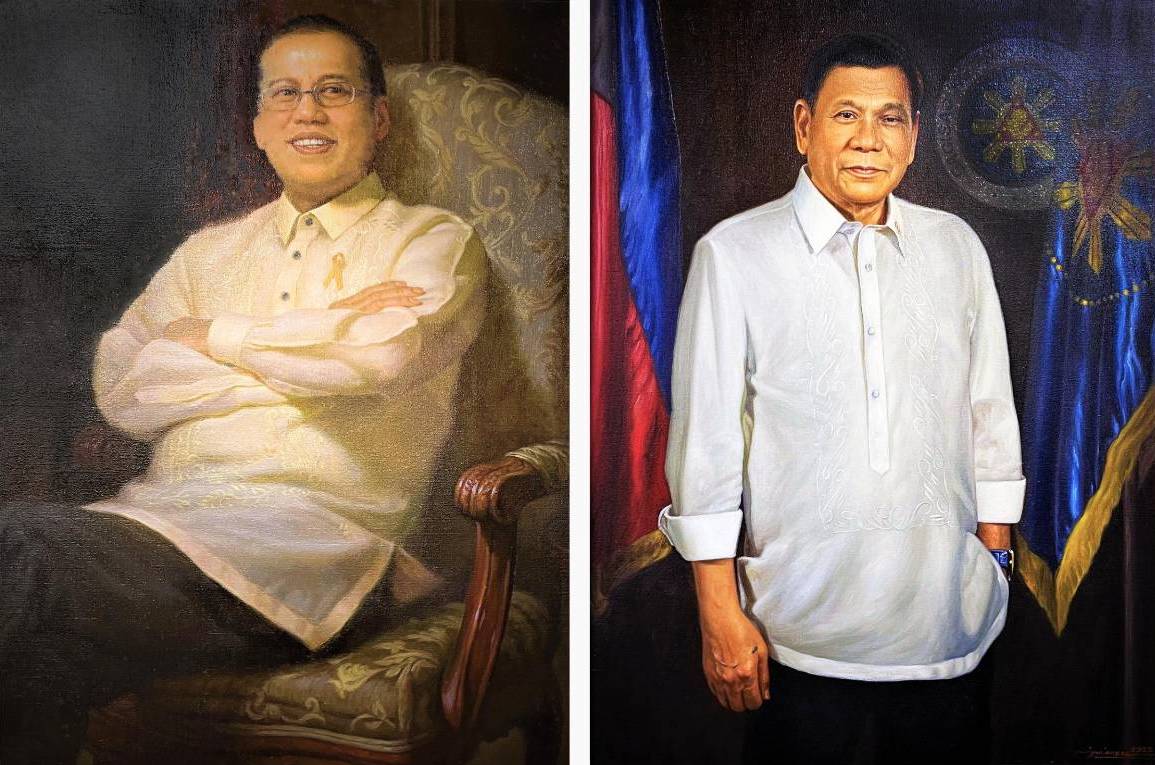
President Benigno S. Aquino III
Benigno S. Aquino III began his public service as the representative of the second district of Tarlac before being elected to the Senate in 2007. Following the passing of his mother, former President Corazon Aquino, in August 2009, he announced his candidacy for the presidency, running on a platform of transformational leadership and good governance. In May 2010, he was elected as the 15th President of the Philippines. His administration is notably credited with the implementation of the K-12 education reform program.
President Rodrigo R. Duterte
Rodrigo Roa Duterte became the first president of the Philippines to hail from Mindanao, marking a significant milestone in the nation's history. His administration prioritized the development of public infrastructure and the enforcement of law and order. Despite facing criticism over his administration’s anti-drug campaign and response to the COVID-19 pandemic, President Duterte maintained high trust and approval ratings throughout his term, reflecting continued public support for his leadership.
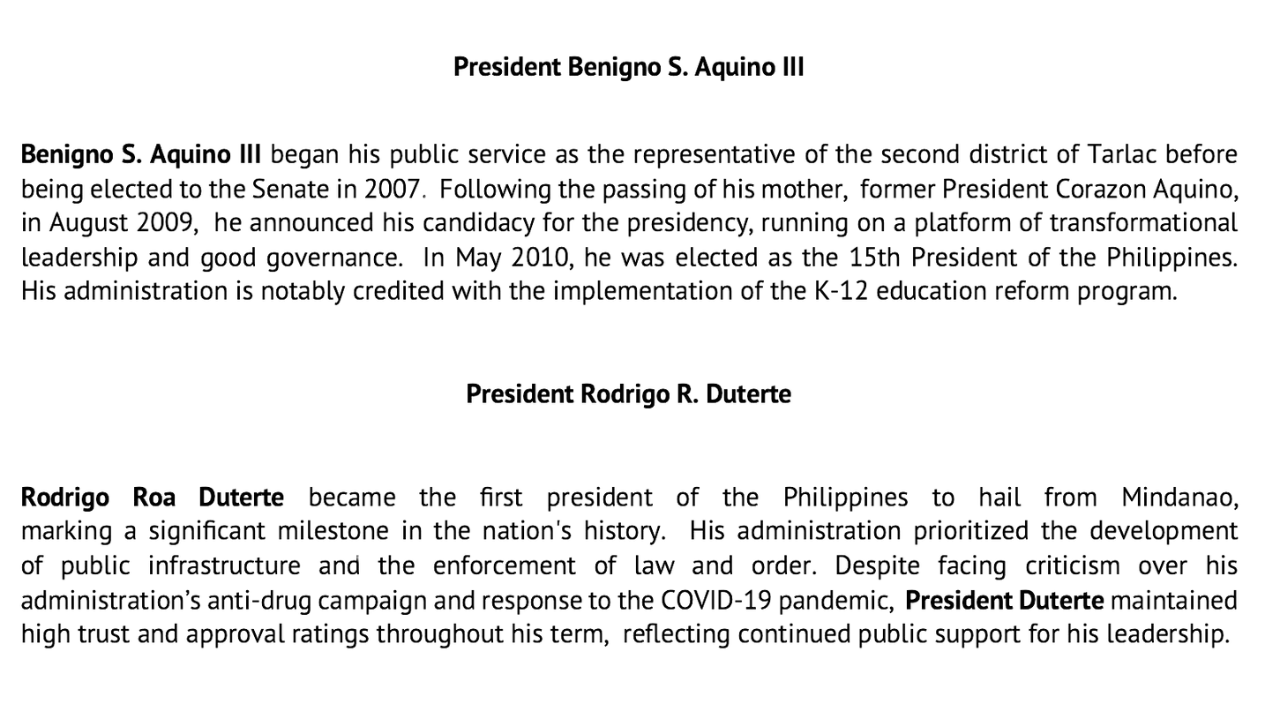
Although First Ladies are neither elected nor appointed, they have often played a significant and influential role in shaping the presidency. They embody grace, beauty, and compassion, offering unwavering support not only to the President but also, by extension, to the nation. Through their nurturing presence, First Ladies help the President navigate the challenges of public life, providing stability and strength during times of pressure.
In recognition of their important role, the portraits of the First Ladies were commissioned by the Cabinet Ladies Foundation in 2000 and beautifully rendered by renowned artist Lulu Coching-Rodriguez.
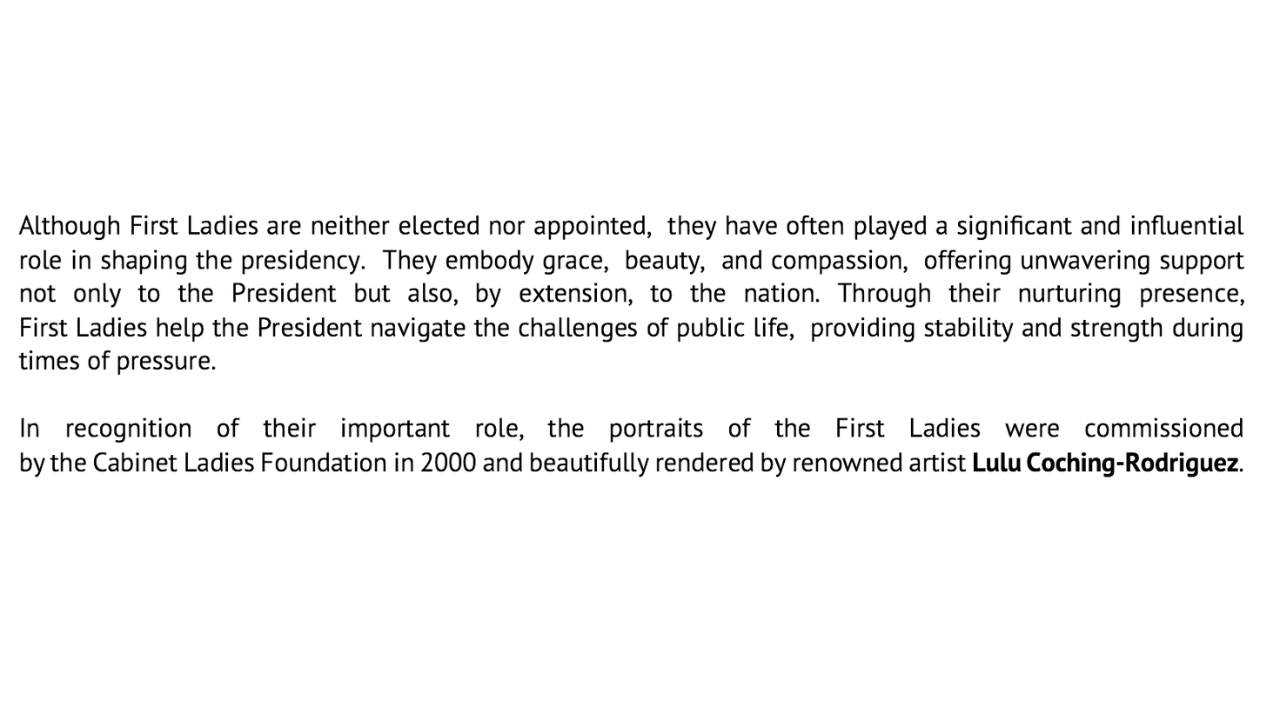
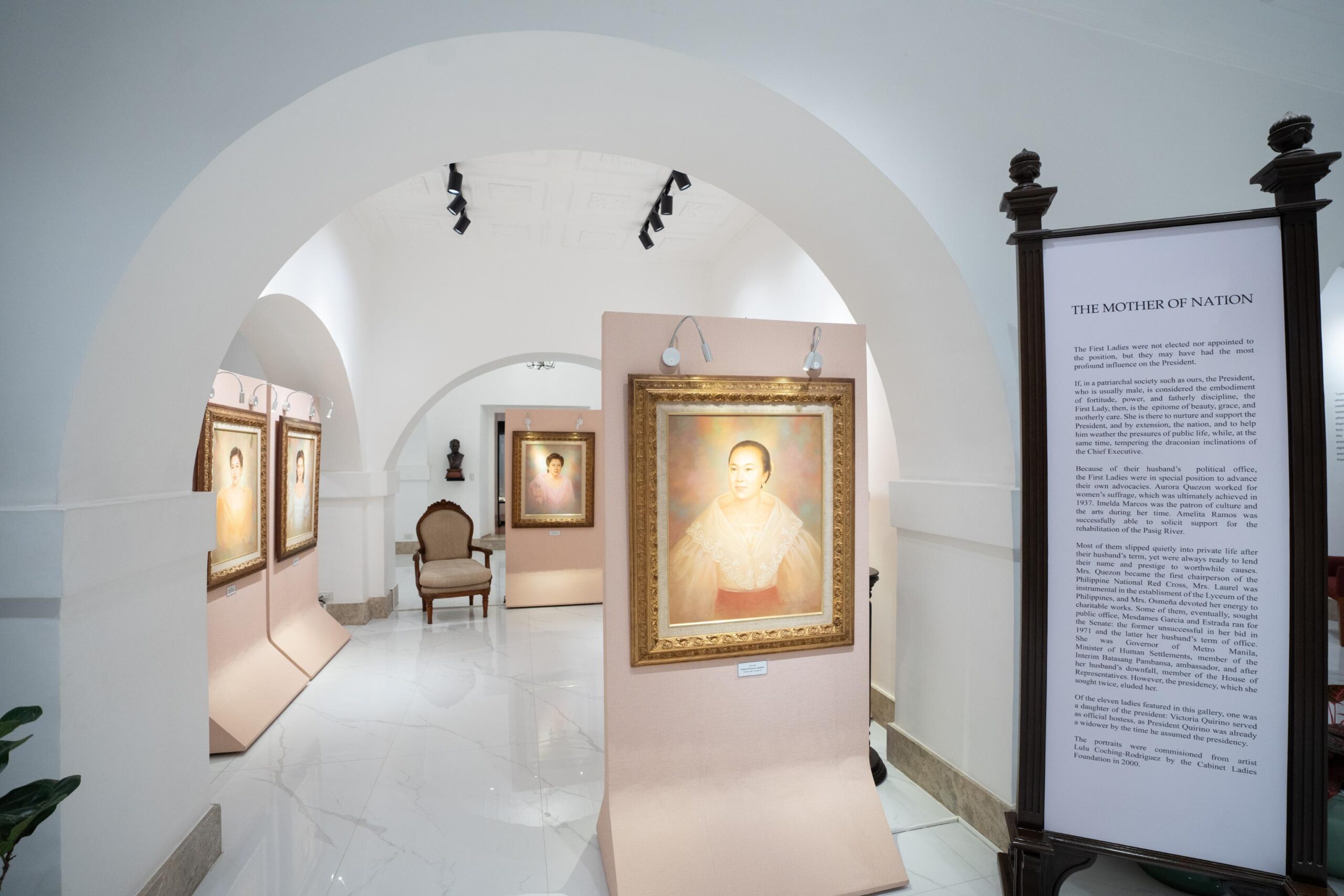
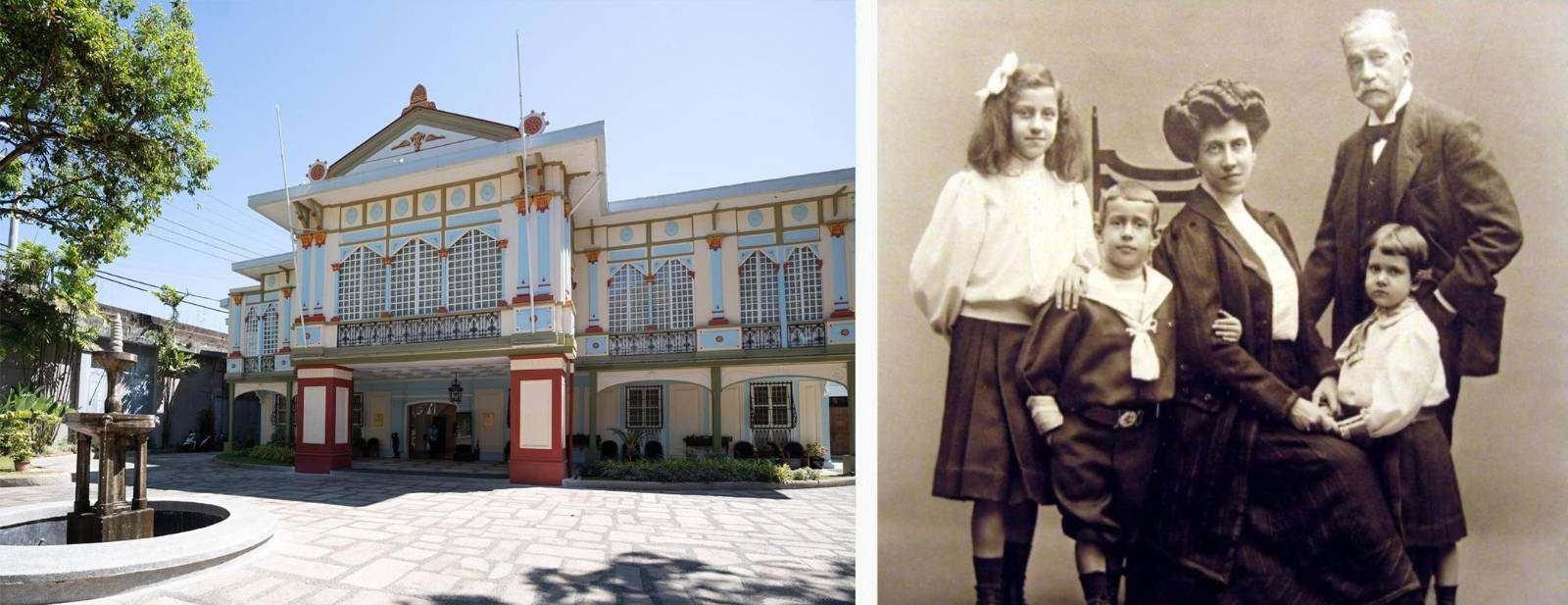
The Teus Mansion, named after Valentín Teus Yrissari, a Basque immigrant who arrived in the Philippines in 1847, stands as a symbol of his success in the sugar and shipping industries. He later founded Tanduay Distilleries, Inc. and, in the 1870s, married the niece of the Governor General, acquiring the mansion as the family home. Upon Don Valentín's passing in 1909, the mansion was inherited by his eldest daughter, Concepción Teus, but with no interest from her descendants, it was eventually offered to Former First Lady Imelda R. Marcos in the late 1970s.
Restored in 1975 by British designer Ronnie Laing and antique dealer Viring de Asis, the mansion served as a guest house for visiting dignitaries of President Ferdinand E. Marcos Sr. Following the events of EDSA I, it remained unused and closed to the public.

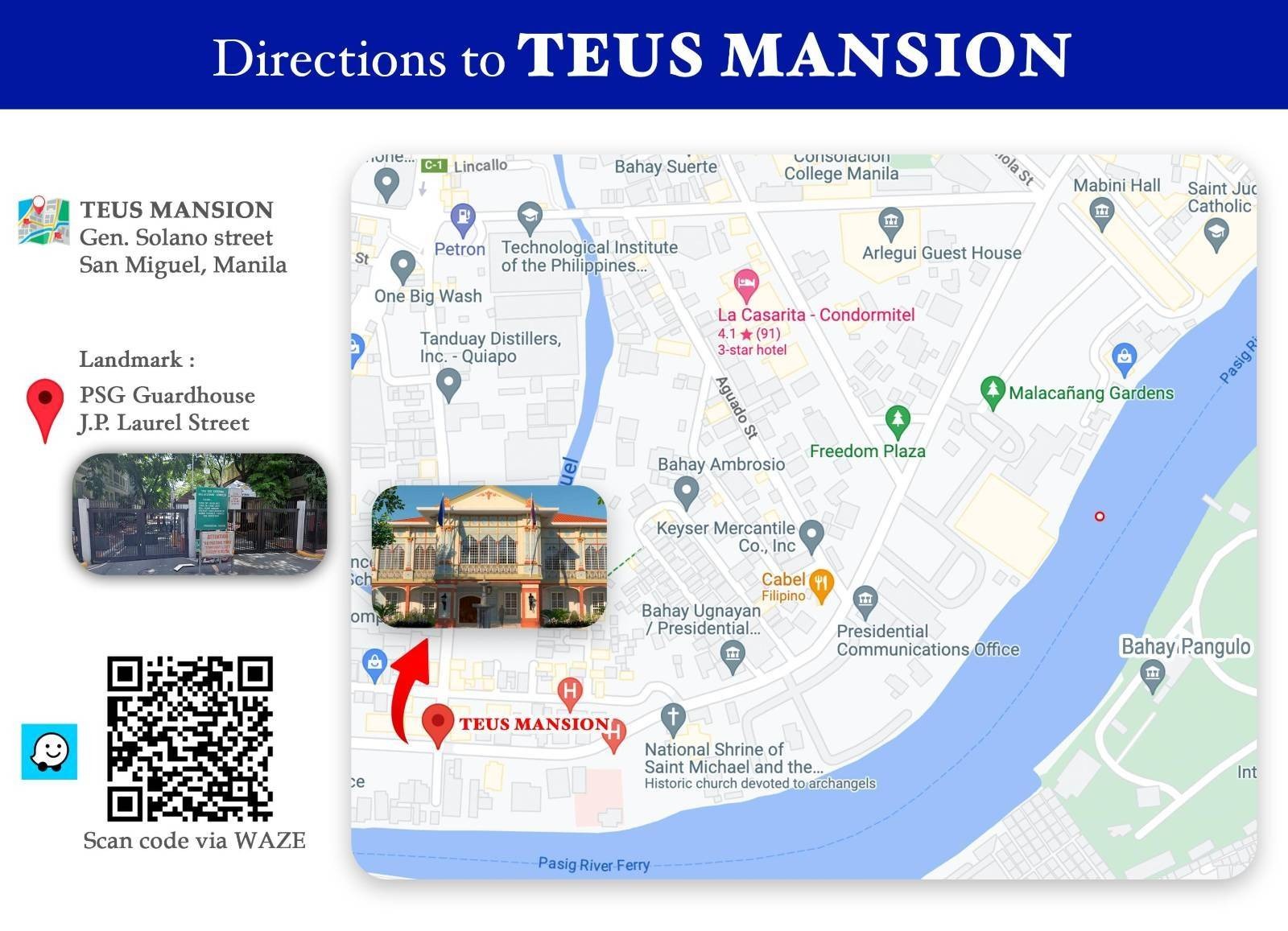
Teus Mansion is open to everyone from Tuesdays to Sundays, 10am to 4pm and the best part - admission is free!
For private guided tours, please email to arrange separately
[email protected]
We'd love to have you visit